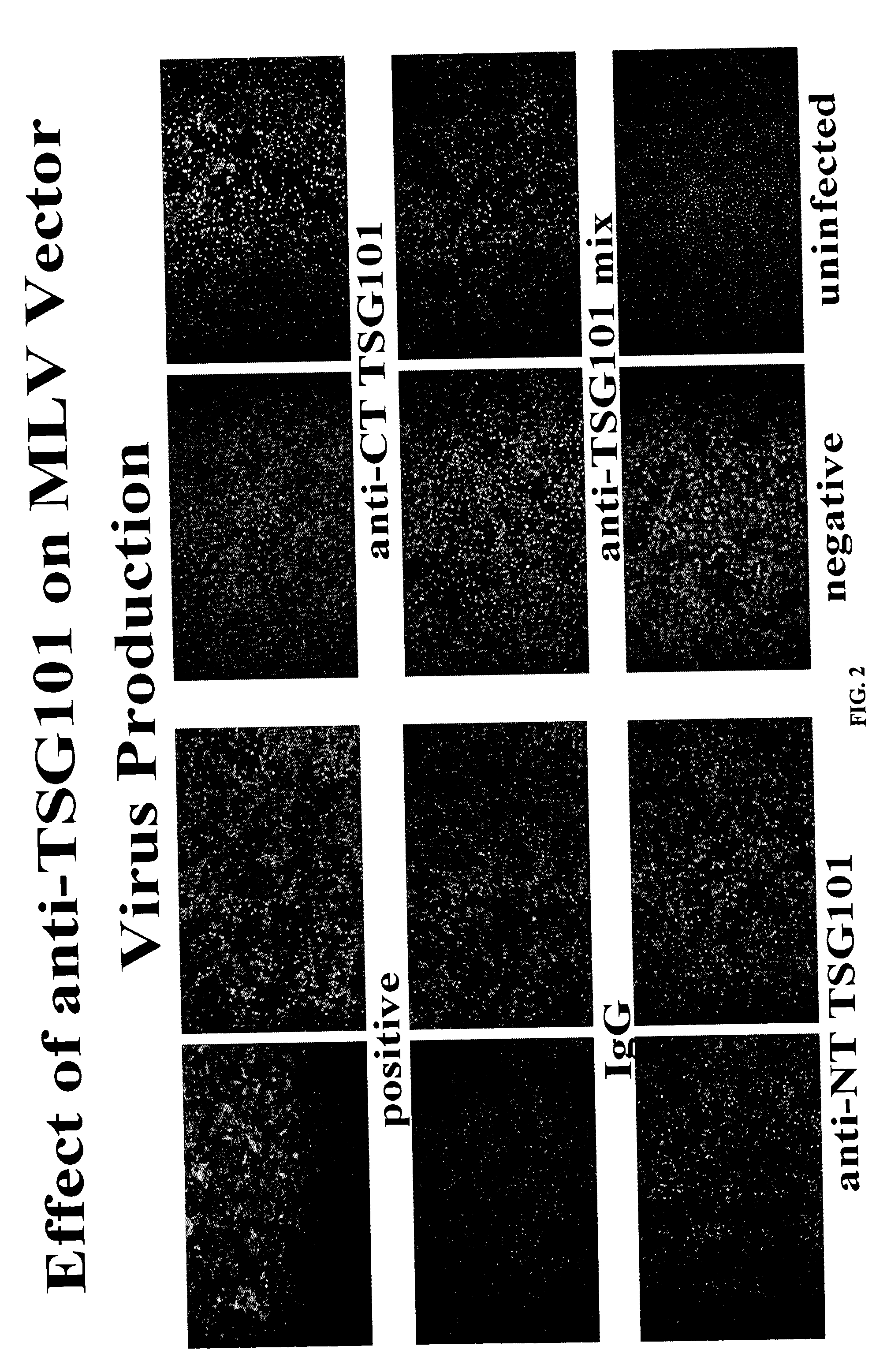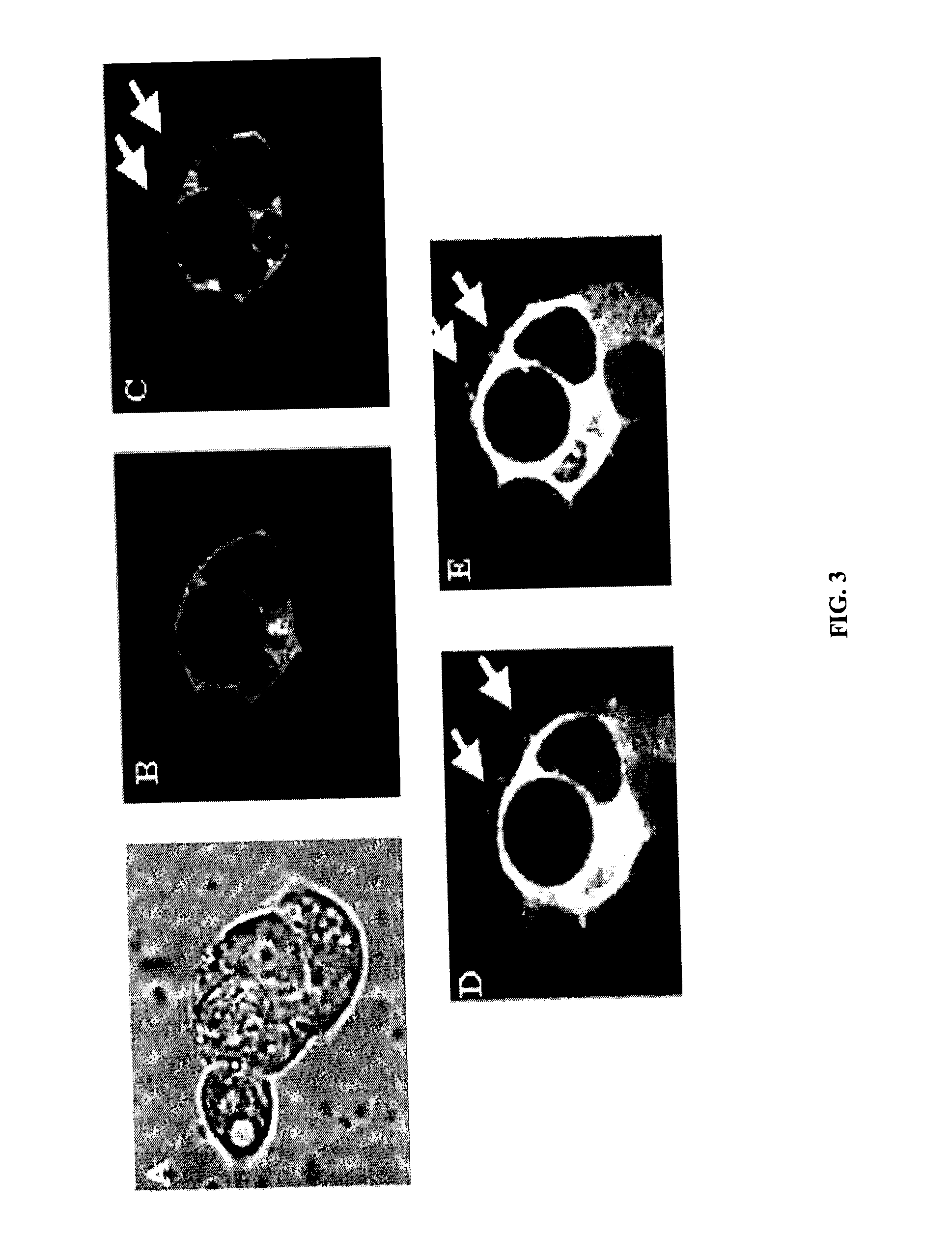Anti-TSG101 antibodies and their uses for treatment of viral infections
an antibody and anti-tsg101 technology, applied in the field of anti-tsg101 antibodies and their use for the treatment of viral infections, can solve the problems of lack of resources to treat the swelling number of recently infected patients, current hiv treatment, and human development catastrophe in developing nations
- Summary
- Abstract
- Description
- Claims
- Application Information
AI Technical Summary
Benefits of technology
Problems solved by technology
Method used
Image
Examples
example 1
6.1. Example 1
Preparation and Uses of Anti-TSG101 Antibodies
[0163] To determine the effect of anti-TSG101 antibodies on viral infections, a retroviral infection assay was developed. A murine leukemia virus (MLV) derived vector which contains an E. coli lacZ gene expressed from the long terminal repeat (LTR) promoter (pBMN-Z-I-Neo) was transfected into an amphotropic murine leukemia retroviral packaging cell line derived from 293 cells (Phoenix A, ATCC). Retroviruses produced by the Phoenix A helper cells were collected and used to infect a mouse N2A cells (ATCC). Anti-TSG101 antibodies were added to 293 helper cells 24 hours after the transfection of the MLV vector. The effectiveness of TSG101 antibodies on viral production was determined by the efficiency of viral supernatant to infect the target cells (N2A). The infection of N2A cells was then determined by cellular staining of .beta.-galactosidase activity (positive cells were stained blue, showed as dark spots in FIG. 2).
[0164] ...
example 2
6.2. Example 2
TSG101 Localized on Cell Surface During Viral Budding
[0167] This example shows that domains of TSG101 are exposed on cell surface during HIV release, and anti-TSG101 antibodies inhibited HIV release and infection.
[0168] 1. TSG101 Localization During Viral Release
[0169] To demonstrate TSG101 is actively involved viral release at plasma membrane, an expression vector of GFP-TSG101 fusion protein was constructed and transfected into Phoenix cells (a retroviral helper cell line developed by Nolan et al of Stanford university) that was actively producing M-MuLV viruses. 24 hours after transfection, GFP-TSG101 fusion protein traffic was observed under confocal microscope (Ultraview, Perkin-Elmer). FIGS. 3A-E show a time course of images of GFP-TSG101 protein translocation from cytoplasm onto cell surface, and then "budding" out of the viral producing cells.
[0170] 2. Cell Surface Localization of TSG101 During HIV Budding
[0171] To determine if TSG101 is also actively involved ...
example 3
6.3. Example 3
Anti-TSG101 Antibodies Inhibit Release of Ebola Virus
[0180] This Example shows that TSG101 interacts with EBOV VP40, that TSG101 is incorporated into EBOV VLPs, and that anti-TSG101 antibody inhibits the release of EBOV virus-like particles (VLPs).
[0181] The only members of the family Filoviridae, EBOV and MARV possess a negative-stranded, non-segmented 19 Kb RNA genome comprising 7 genes: nucleoprotein(NP), viral proteins VP35, VP40, glycoprotein (GP), VP30, VP24, and RNA polymerase(L), encoding for seven proteins in MARV and eight proteins in EBOV. Recent studies provide some insights in the cellular localization and role of VP40, a 326 amino acid matrix (M) protein (Jasenosky et al., 2001, J Virol 75(11): 5205-14; Kolesnikova et al., 2002, J Virol 76(4): 1825-38). In cells infected with either EBOV or MARV, the majority of VP40 is peripherally associated with the cytoplasmic face of the plasma membrane via hydrophobic interactions. Significantly, expression of EBOV ...
PUM
| Property | Measurement | Unit |
|---|---|---|
| Therapeutic | aaaaa | aaaaa |
| Fluorescence | aaaaa | aaaaa |
Abstract
Description
Claims
Application Information
 Login to View More
Login to View More - R&D
- Intellectual Property
- Life Sciences
- Materials
- Tech Scout
- Unparalleled Data Quality
- Higher Quality Content
- 60% Fewer Hallucinations
Browse by: Latest US Patents, China's latest patents, Technical Efficacy Thesaurus, Application Domain, Technology Topic, Popular Technical Reports.
© 2025 PatSnap. All rights reserved.Legal|Privacy policy|Modern Slavery Act Transparency Statement|Sitemap|About US| Contact US: help@patsnap.com



